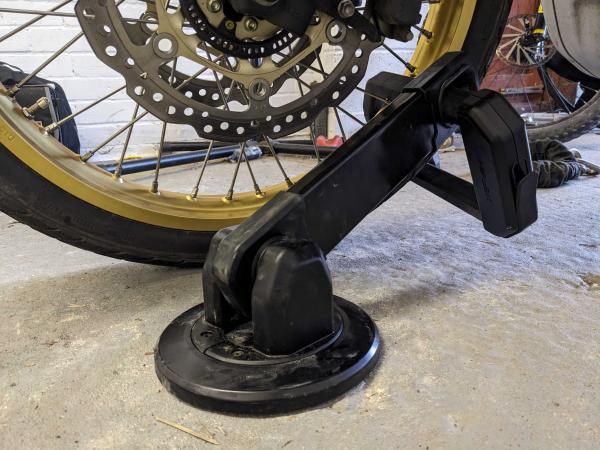
If you have a decent budget for bike security, is it worth splurging on the Hiplok AX1000 and DX1000?
People will often tell you there’s only so much you can do to prevent bike theft. If they really want it, they’re having it - determination and the advent of battery-powered angle grinders mean that all you can do is make the criminal’s life more difficult in the hope they either give up, get spooked or simply target someone else.
In terms of making life more difficult, the Hiplok AX1000 ground anchor is right up there at the top, especially when combined with the DX1000 D-lock from the same company. The products are made from a graphene composite specifically designed to resist angle grinder attaches.
Hiplok says it took over eight minutes to cut through one side of the AX1000, many times more than the 90 seconds of sustained angle grinder attack security products must withstand to be given the Sold Secure rating. Cutting one side is only half the job - you’d need to cut the other to free any lock put through the middle. The tests also used up five grinding discs.
Independent tests have shown the 1000 Series range of products to be similarly stubborn when worked on with an angle grinder, with a similarly hungry appetite for cutting discs too. So, rather than hack our test samples up, we’re focusing more on the installation and day-to-day usage in our review. I’ve had the AX1000 installed in my garage for around two months and have locked up several different bikes with it.
Key features
- 360-degree rotating arm with 180 degrees of pivot
- Angle grinder-resistant graphene composite construction
- Rubberised to protect bike finish
- Weather-resistant rubber lock cover
Installing a Hiplok AX1000 ground anchor
The last ground anchor I had put in my garage was secured by four bolts, but the AX1000 is fixed to the floor with eight. Drilling eight 60mm deep holes (there’s a 16mm drill bit included) takes a bit of time, and although there is a template included, keeping all of them lined up properly is easier said than done, especially if the floor you’re drilling into is a bit uneven, causing the drill bit to jump around a bit when making pilot holes. Being especially incompetent at DIY, I did get some help for this…
Part of the plastic casing of the unit - secured by four small Allen bolts - needs to be removed to get to the bolt holes. Unfortunately, one was extremely tight, to the point of bending Allen keys and a slight rounding of the head, but thankfully, it was eventually extracted. Causing a further delay was one of the expansion sleeves falling apart.
After that, though, it’s all easy - simply a case of putting an expansion sleeve in each hole, bunging the anchor on top, and bolting the thing down. At this point, you need to be absolutely sure you’re happy with the placement, as the next step is hammering a ball bearing in each of the main bolts, ensuring a would-be thief can’t simply smash the plastic shroud and undo the whole assembly. Once those bearings are in, the AX1000 is fitted permanently.
Using the AX1000 ground anchor and DX1000 D-lock
The manual suggests either positioning the anchor just behind or in front of the front wheel just ahead of the rear for fitting to the swing arm or part of the frame.
I’ve generally put the D-lock through the front wheel and tyre, although on some bikes with wider front wheels, you may need to put it around a spoke instead. The manual also suggests placing the swing arm of the anchor just in front of the rear wheel to lock to the swing arm, although, on our Honda XL750 Transalp long-term test bike, it’s not possible to get the D-lock around it at the right angle.
The D-lock is reassuringly chunky and also rubberised, so you don’t have to fret about scratching anything up on your bike. It’s a good size, so it’s easy enough to put around the front wheel even with the bike on its side stand and at an awkward angle. That said, the D-lock is a little limiting - I have at times combined it with a Kryptonite New York Fahgettaboudit chain, which fits through the AX1000 despite being one of the chunkiest chains out there.
One of these or one of Hiplok’s chains would unlock the true flexibility of the ground anchor, which rotates 360 degrees on its base, while the arm can pivot through 180 degrees. Stick in the anchor in the middle of the garage, and you could park your bike in all manner of spaces and still be able to lock it up. The only problem is, any of these chains introduces a weak point, as they’re not as resistant to angle grinder attack as the D-lock.
The D-lock is, at least, a nicely compact thing to take out with you for peace of mind away from home, and the weight isn’t so bad at around 2kg. Should you also have a nice bicycle you want to keep protected, the DX1000 is an easy thing to chuck in a rucksack and take with you on a pedal to the shops.
Should you buy a Hiplock AX1000 ground anchor and CX1000 D-lock?
If you’re happy to spare no expense in protecting your pride and joy, then yes. Short of employing a full-time security guard, you’ll struggle to do better. Motorcycle security devices are no good if they’re so much of a pain to use that you’ll fall into the habit of not bothering to lock up after every ride, but thankfully, the 1000 series products are extremely easy to live with despite their burly nature.
All of this security and useability does, of course, come at a cost - £299 for the DX1000 D-lock on its own, £349.99 for the AX1000 ground anchor, or £599.99 for the 'Hiplok 1000 Series Ultimate Bundle' with both. For some, those prices may make the 1000 series a non-starter. But if you can stretch yourself, it’s worth it.

